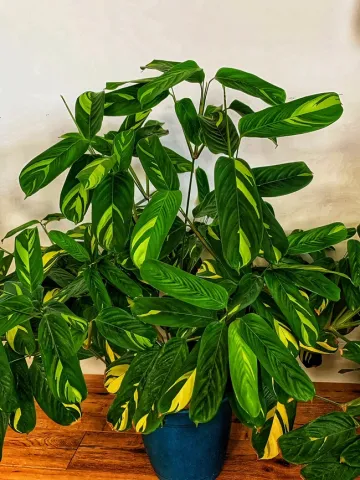
Golden Mosaic Prayer Plant
By Deborah Light-Pacheco UCCE Master Gardener
Common name of plant : Never Never Plant, Golden Mosaic Prayer Plant
Scientific name: Ctenanthe
Planting area: Sunset zones 23, 24; H1, H2; or indoors
Size: 2-3 feet tall, 1 ½-3 feet wide
Bloom Season: small, insignificant flowers at intervals throughout the year.
Exposure: Partial shade; bright indirect light
Pruning needs: Needed to control size and remove dead foliage
Water needs: Ample
Snapshot: Ctenanthe or the Never Never Plant is an evergreen plant native to Brazil. Its long oval leaves are variegated in shades of green, yellow and white/silver and if well maintained, will become quite a showpiece as it displays its multi-colored foliage on bamboo-like stems. This plant is in the prayer plant family and may fold up its leaves at night, a behavior known as nyctinasty.
The growth potential of the plant will depend on the species and the size of the container, but it can become quite tall and wide. Ctenanthe may need to be repotted every 1-2 years in the spring. Use a well-draining soil; a potting mix or potting soil with equal parts of peat and perlite and keep the soil most but not waterlogged. Fertilize monthly during the growing season with a half strength multi-purpose fertilizer. Provide bright light but not direct sun. Too little light will result in solid green foliage without the attractive color variations.
Water thoroughly, then repeat when the topsoil dries. Use filtered, distilled or captured rainwater. The sodium in tap water may cause the leaves to brown. On the Central Coast, Ctenanthe can grow outside for most of the year, with temperatures between 55-85 degrees Fahrenheit, but relocate indoors once temperatures dip below 55 F.
Propagation is done by division during the spring. It is best to propagate using the same type of soil as used for the parent plant. Ctenanthe species are non-toxic to pets and they are efficient air purifiers.
Common pests include mealybugs, thrips and spider mites, all of which can be treated with OTC soap for houseplant pests. Wet soil may lead to Botrytis, a common fungal disease.
We are still here
You can view workshops on Instagram live at slo_mg or visit our You Tube channel at “San Luis Obispo County UC Master Gardeners.”
Visit our website at ucanr.edu/sites/mgslo/ or email us questions at anrmgslo@ucanr.edu.
Our physical offices are closed, but you can still reach us:
San Luis Obispo: 805-781-5939
Arroyo Grande: 805-473-7190
Templeton: 805-434-4105

